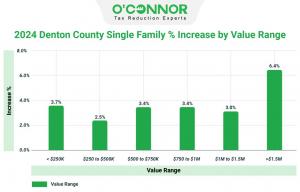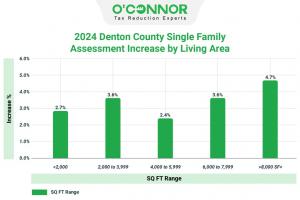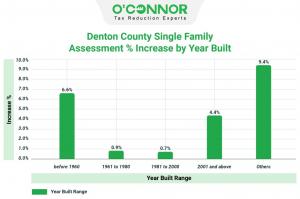Denton Central Appraisal District Nudges Property Taxes For Homeowners In Flat Market
O'Connor has finished a report for the Denton Central Appraisal District, which lowers property taxes for homeowners in a flat market.
DALLAS, TEXAS, UNITED STATES, May 6, 2024 /EINPresswire.com/ -- Denton Central Appraisal District bumped property tax assessments for houses but sledge-hammered tax assessments for commercial properties upward. The property tax assessments of Denton County homes increased 3.2%, which is in-line with analysis by Realtor.com (+5%), Movoto (+3.1%) and Zillow +(0.2%).The increases by DCAD are based on home values as of January 1, 2024. The appreciation rates for Realtor.com, Movoto and Zillow are for either January 2023 vs January 2024 or March 2023 vs March 2024. While the increased tax assessments for homes and condos are in-line with industry estimates, the tax assessments for commercial properties are out of whack with trends reported by industry participants and Wall Street Analyst Green Street.
Huge Tax Increases in Denton County for Commercial Property Owners
Denton Central Appraisal District increased the value of Denton County commercial property from $43 billion to $55 billion, a 28.2% increase. Green Street, a Wall Street advisory firm reports commercial property values fell 7% during 2023 and are off 21% since the peak in 2022. Hence the DCAD estimated increase is directionally different and varies by 35% from the change estimated by Green Street
Green Street reports that all categories of commercial property have declined since the peak in 2022. Changes for the major property categories since the peak in 2022 are -37% (office), -28% (apartment), -17% (strip retail) and -16% warehouse.
The massive decline in the value of commercial property in Denton County, the Dallas Fort Worth area, Texas and the U.S. has been caused by higher interest rates, higher expenses (particularly casualty insurance, property taxes and labor) and tougher underwriting by lenders.
COVID Crushes Already Low Rates
COVID became an issue in the U.S. in March 2020. Interest rates had already been low for many years. Between 2011 and March 2020, the 10-year-treasury rate fluctuated between 2.0 and 2.5%. COVID caused a short-term cessation of much economic activity and further reduced the 10-year-treasury rate by half, to about 1%. Economic activity was slow during the first several quarters after COVID hit. But by late 2020 and through 2021 a veritable stampede occurred to buy stabilized commercial real estate with ultra-low interest rates. Many transactions during this period involved loans with floating rate interest rates at 3% with corresponding aggressive loan underwriting. Low interest rates and over-sized loans caused real estate values to pop in 2021 and through the first part of 2022.
Party Is Over by Mid-2022
The stampede was largely over by mid-2022, although a volume of pending transactions in the pipeline in mid-2022 closed in the third and fourth quarters of 2022. The following graph provided by Enriched Data documents the rapid increase in sales and mortgage activity in 2021 and 2022 followed by the collapse of both in 2023.
Tough Times for Commercial Property Owners
While the volume of sales activity doubled during 2021 and 2022, it crashed in 2023. Prices during 2011 to 2020 were based on 10-year-treasury rates of 2.0 to 2.5%. In 2021 and early 2022, prices soared based on 10-year-treasury rates of 1% and lower. But commercial sales and mortgage financing collapsed as rates rose steadily throughout 2022 reaching about 4% in early 2023.
Why Are 10-Year-Treasury Rates Important?
The value of income properties is based on a combination of the net income (revenue, less operating expenses) and the capitalization rate. The capitalization rate is used to convert net income into an estimate of market value. Actual market value is best determined in the marketplace between buyers and sellers. In simple terms, the capitalization rate is a combination of 1) interest rate (typically 10-year-treasury for commercial real estate) and 2) risk. There are many types of risk including management, market, interest rate, liquidity, leverage, and legislative.
So, Again, Why is 10-Year-Treasury Rate Important?
The capitalization factor is the sum of 1) interest rate and 2) risk. Assume risk constant for moment. If interest rates increase, the capitalization rate increases and the value of real estate declines. It works just like with bonds. The value of bonds rise as interest rates fall and decline as interest rates rise.
Interest Rates Went from 1% to 4% in 18 Months
When interest rates rose from the ~2% range (and lower in early COVID) to about 4%, the value of real estate fell sharply. The markets essentially froze because owners were not willing to sell in most cases unless in financial distress or required to sell based on partnership documents. Prices would have fallen even further except for the myopic belief that interest rates would quickly decline back to 2% or so. It has now been almost 2 years since interest rates closed on 4% and we are still waiting for interest rates to collapse. However, inflation is more stubborn than expected and interest rates are stickier than expected.
Appraisal districts reacted when interest rates collapsed, and prices rose. However, appraisal districts are behind valuation trends because they have not recognized the sharp rise in interest rates and its impact on commercial property values.
The strength of the housing market is somewhat of a conundrum. When interest rates rise, homes are less affordable, and there are typically fewer buyers leading to lower prices. That has not occurred because of pent-up demand to purchase homes left over from COVID. Realtor.com, Movoto and Zillow all reported modest home price increases in 2023 that are consistent with the 3.2% increase applied by Denton Central Appraisal District. The increase is about the same for all value strata except for homes over $1.5 million which increased by 6.4%.
Property tax assessment increases in Denton County in 2024 were roughly the same regardless of home size, although homes over 8,000 SF did have the largest level of upturn.
The property tax assessment increase does not seem tied to the year of construction, although homes built prior to 1960 had the largest increases (except for the tiny segment “Other”). This may be due to better locations. The “other” category represents properties that do not have a year of construction indicated in tax records, and are small as a portion of the total, only about 0.5% of the total.
There were 14,729 home sales in Denton County during January 2023 through March 2024. Roughly half of these homes were given a 2024 property tax assessment higher than the sales price and half were given a tax assessment less than the sales price.
Appraisal districts use a process termed “mass appraisal” to estimate the value of real estate. Mass appraisal uses property descriptions, cost and depreciation tables and a math model to estimate value. Appraisal districts are prohibited from simply valuing homes that sell based on the sales price; they are required to apply the same data tables and math model to homes in a subdivision.
Denton Commercial Property Values Soar; At Least as Estimated by DCAD
Denton Central Appraisal District increased the taxable value of all types of commercial property. The increases are hardest to understand for office. Office values have been crushed since COVID hit. The amount of occupied office space has declined since 2020 while 8 million square feet of space were adding in the Dallas Fort Worth area. To provide perspective, there is 317 million SF of office space in the DFW area, of which 65 million SF are vacant available for lease and another 11 million SF are leased but vacant (and available for sublease). So, a total of 76 million SF of vacant office space. In total, 24% of DFW office space is vacant. Prior to COVID, typical absorption was 4 MM SF. At this pace, it would take 11 years to lease to 90%.
While the 10-year-treasury rate affects all types of commercial real estate, other factors such as higher costs and tougher loan underwriting affect some more than others. Office is generally agreed to be most impacted.
Increases of 20 to 34% were given to all vintages of commercial real estate in Denton County. There does not appear to be a clear reason that increases are higher for some categories. However, in a tough market there is a move to quality and the higher increases for newer buildings may reflecting that trend.
The assessment increases for buildings valued over $5 million are roughly triple the level of increase for building assessed for under $5 million. There is a 20% “circuit breaker” cap in place for commercial buildings, land and rental homes valued under $5 million, but just for 2024, 2025 and 2026. However, the 20% circuit breaker should not be a factor in determining proposed values. Of course, the 10% homestead cap limits the actual increase in taxable value for homesteads and has for decades.
The magnitude of the increase for apartments is surprising and inconsistent with the size of increases for apartments in other counties. For counties analyzed already in 2024, the property tax assessment increases for apartments are:
Harris County 1.2%
Fort Bend County 4.7%
Williamson County 8.4%
Travis County 9.2%
Denton County 42.3%
Hence, the 42.3% increase by Denton Central Appraisal District appears to be an anomaly compared to the increased in tax assessments by other large Texas appraisal districts.
The DCAD increases are 33 to 44% for all vintages (except other which do not have a year built attached but are a tiny portion of the total.)
The increases for office are smaller in magnitude than for apartment and warehouse, but they are larger than for land and hotels. Any increase in taxable value seems inappropriate given the staggering and unprecedented nature of the calamity facing owners of office buildings. Tax assessments for all vintages of office buildings were increased over 10%, with the exception of Denton County office buildings built between 1961 and 1980, which rose 6.2%.
Denton County retail property tax assessments rose 15 to 20% regardless of when they were built. These increases are material and seem inconsistent with the higher level of interest rates and capitalization rates. Sales of retail buildings are down 50% from the peak.
Wow! These increases for warehouse buildings are mind-boggling. Buildings valued at less than $5 million will benefit from the 20% circuit breaker cap for 2024, 2025 and 2026. Increases like these might be expected in boom times but seem out of step given the difficult nature of the commercial real estate market with both sales and mortgages down sharply with no immediate relief in sight.
Both traditional and medical office building tax assessments were increased by double digit levels. These assessment hikes will raise property taxes for Denton County office building owners by over $18 million (based on 2.5% tax rate) if not reduced during property tax appeals.
Tax increases for smaller apartment buildings were increased by almost double the level for larger apartments in Denton County. These increases total over $6 billion and will increase property taxes for apartment owners by over $150 million if not reduced as a result of property tax appeals. While owners would like to pass along the higher property taxes in higher rents, rents are a function of market supply and demand and are not normally passed through to tenants in the short term. However, in the long term the full costs of owning and operating apartments will be included in rental rates paid by tenants.
Retail building owners face property tax increases of almost 20% in Denton County for 2024. However, most retail leases allow the owner to “pass through” higher property taxes to tenants. Based on an assessment increase of about $1 billion, Denton County retail tenants face paying higher property taxes totaling about $25 million based on preliminary tax assessments.
Warehouse building owners face tax increases approaching 40% unless they are valued at $5 million or below and partially protected by the 20% circuit breaker cap. The increases appear to have been applied equally to both traditional warehouses and mini-warehouses (aka self storage), based on the preliminary tax assessments.
What are Preliminary Tax Assessments from DCAD?
Texas appraisal districts, including Denton Central Appraisal District, are charged with providing an estimate of market value for real estate and taxable business personal property in the county. Texas has 254 counties and 253 appraisal districts (Potter and Randall Counties combine their efforts to reduce costs to taxpayers.) However, the magnitude of the appraisal assignment is immense when compared to the resources available. Texas has 22 million tax parcels and Texas appraisal districts employ 2,278 appraisers. About 75% of the appraisers are involved in field operations for measuring new property and remodeled property. Hence, less than 600 appraisers are responsible for building math models that value 22 million tax parcels. That works out to about 36,600 properties to appraise per appraiser. The total budget for Texas appraisal districts was $618 million in 2022, the last year for which data is available.
Denton Central Appraisal District has 459,000 tax parcels, a budget of $15 million and 39 total appraisers, based on 2022 data from the Texas Comptroller. Assuming 75% of appraisers work in field, this indicates each appraiser building math models is responsible for valuing 47,000 tax parcels.
How Does One Person Value 47,000 Properties per Year?
Appraisal districts use a process termed mass appraisal, which relies on data tables with property characteristics and separate data tables with cost factors and depreciation schedules. Given the workload, the appraisers rarely see the properties they are valuing. They rely on data tables and math models to generate “preliminary values”.
Why Are Values Preliminary?
Noticed values sent by Texas appraisal districts in April and May are preliminary because: 1) appraisal districts understand they are estimates based on imperfect data and 2) more importantly, property owners have the right to contest the “preliminary values” each year, whether they are up, flat, or down.
About O'Connor:
O’Connor is among the largest property tax consulting firms in the United States, providing residential property tax reduction services in Texas, Illinois, and Georgia, as well as commercial property tax reduction services across the United States. O’Connor’s team of professionals possess the resources and market expertise in the areas of property tax, cost segregation, commercial and residential real estate appraisals. The firm was founded in 1974 and employs more than 600 professionals worldwide. O’Connor’s core focus is enriching the lives of property owners through cost effective tax reduction.
Property owners interested in assistance appealing their assessment can enroll in O’Connor’s Property Tax Protection Program ™. There is no upfront fee, or any fee unless we reduce your property taxes, and easy online enrollment only takes 2 to 3 minutes.
Patrick O'Connor, President
O'Connor
+ + +1 713-375-4128
email us here
Visit us on social media:
Facebook
Twitter
LinkedIn
YouTube
Legal Disclaimer:
EIN Presswire provides this news content "as is" without warranty of any kind. We do not accept any responsibility or liability for the accuracy, content, images, videos, licenses, completeness, legality, or reliability of the information contained in this article. If you have any complaints or copyright issues related to this article, kindly contact the author above.




